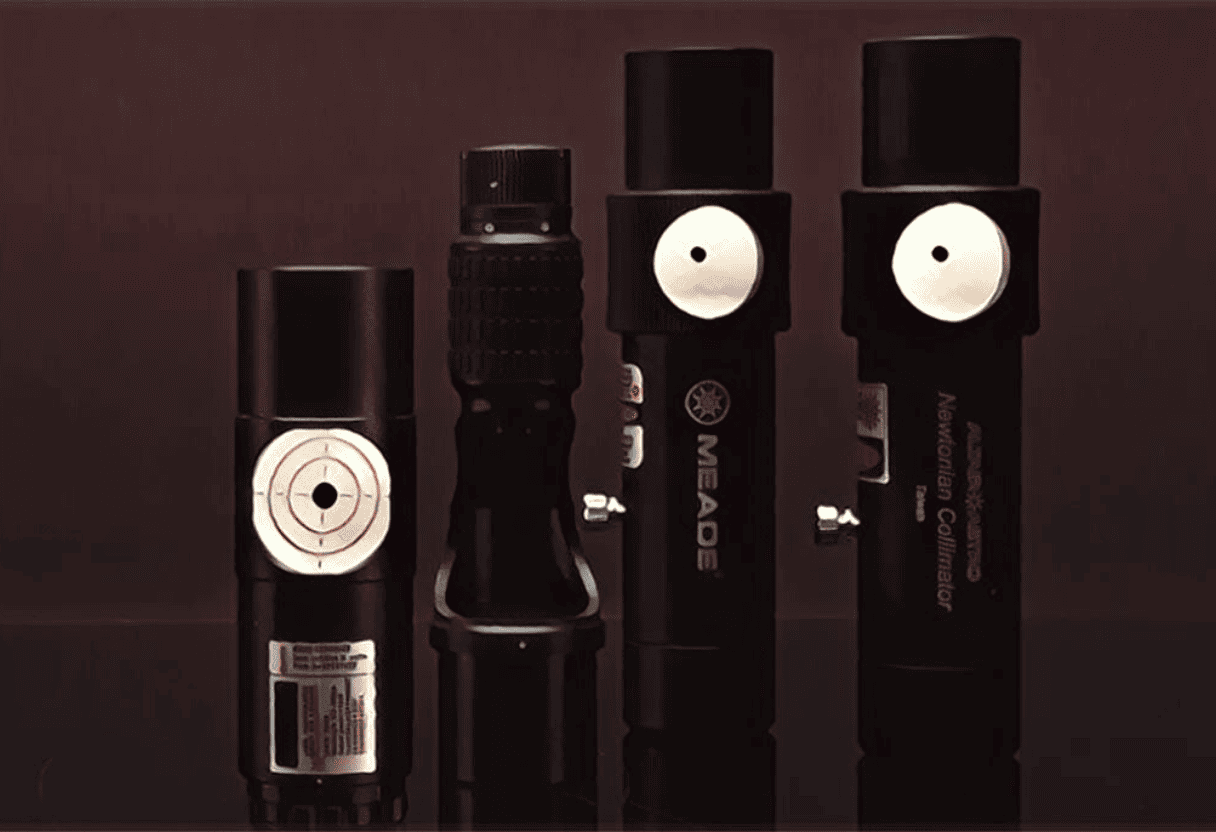As an astronomy enthusiast, you’re likely aware of the critical importance of a well-aligned telescope for a clear and crisp view of the night sky.
This is where a laser collimator becomes an essential tool, especially for reflector telescope users. A laser collimator simplifies the collimation process by projecting a laser beam into the optical system, allowing you to adjust the mirrors for perfect alignment.
Well, we’ll be going over:
- What features should you look for in a laser collimator, and why are they important for precise telescope alignment?
- Which laser collimators are currently considered the best in the market for ensuring precise alignment of telescopes?
- How do these top laser collimators compare in terms of ease of use, build quality, and alignment precision?
A good laser collimator is an investment in the quality of your astronomical observations.
Let’s dive in.
Top Laser Collimators
- SVBONY Laser Collimator – Top Pick
- Astromania Next Gen Laser Collimator
- Astromania Next Gen Laser Collimator
- Alstar Laser Collimator
- SOLOMARK NextGen Laser Collimator
After careful research and considering a wide range of factors, I’ve compiled a list of the best laser collimators on the market. These tools are crucial for astronomers and enthusiasts looking to get the most precise alignment for their telescopes, ensuring clarity and sharpness in their observations. The following products represent the top choices for durability, accuracy, ease of use, and overall quality. Whether you’re a seasoned astronomer or just starting out, you’ll find a laser collimator here that fits your needs and budget.
SVBONY Laser Collimator
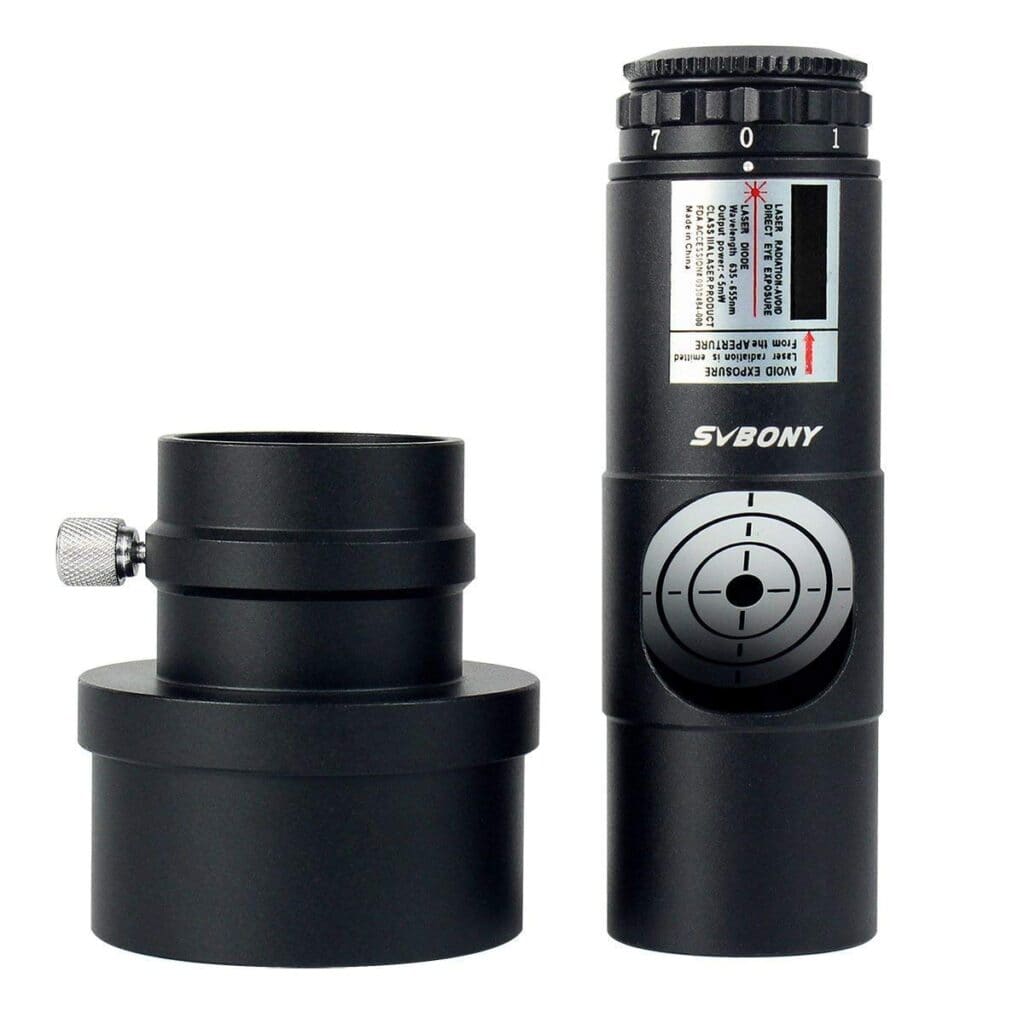
I recently got my hands on the SVBONY Laser Collimator, and I think it’s a must-have for any Newtonian telescope owner looking to achieve sharp and precise views.
Pros
Cons
I had the opportunity to use the SVBONY Laser Collimator on my Newtonian reflector telescope. The process was intuitive – in just minutes I achieved a much clearer image than with my previous manual collimator. There’s a noticeable difference in alignment precision, especially when viewing celestial bodies at high magnifications.
The device’s seven brightness levels are a blessing. Whether I’m setting up at dusk or in the dead of night, I can easily adjust the laser for optimal visibility. It’s this kind of flexibility that enhances the user experience.
I’ve had collimators made of cheaper materials, but this one’s solid metal body stands out. It’s the kind of tool that feels like it’s going to last for years, not just sessions. Although I needed to check the collimation of the laser itself upon arrival, once adjusted, the tool worked flawlessly.
With its removable adapter, it accommodates both 1.25” and 2” reflector telescopes, demonstrating versatility. However, I would have appreciated a more detailed step-by-step guide provided with the collimator for newcomers to the process.
In conclusion, if you’re in the market for a reliable laser collimator, the SVBONY model is a stellar choice. Despite some minor setbacks, the ease of use and quality construction make it a valuable addition to any amateur astronomer’s toolkit.
Astromania Next Gen Laser Collimator
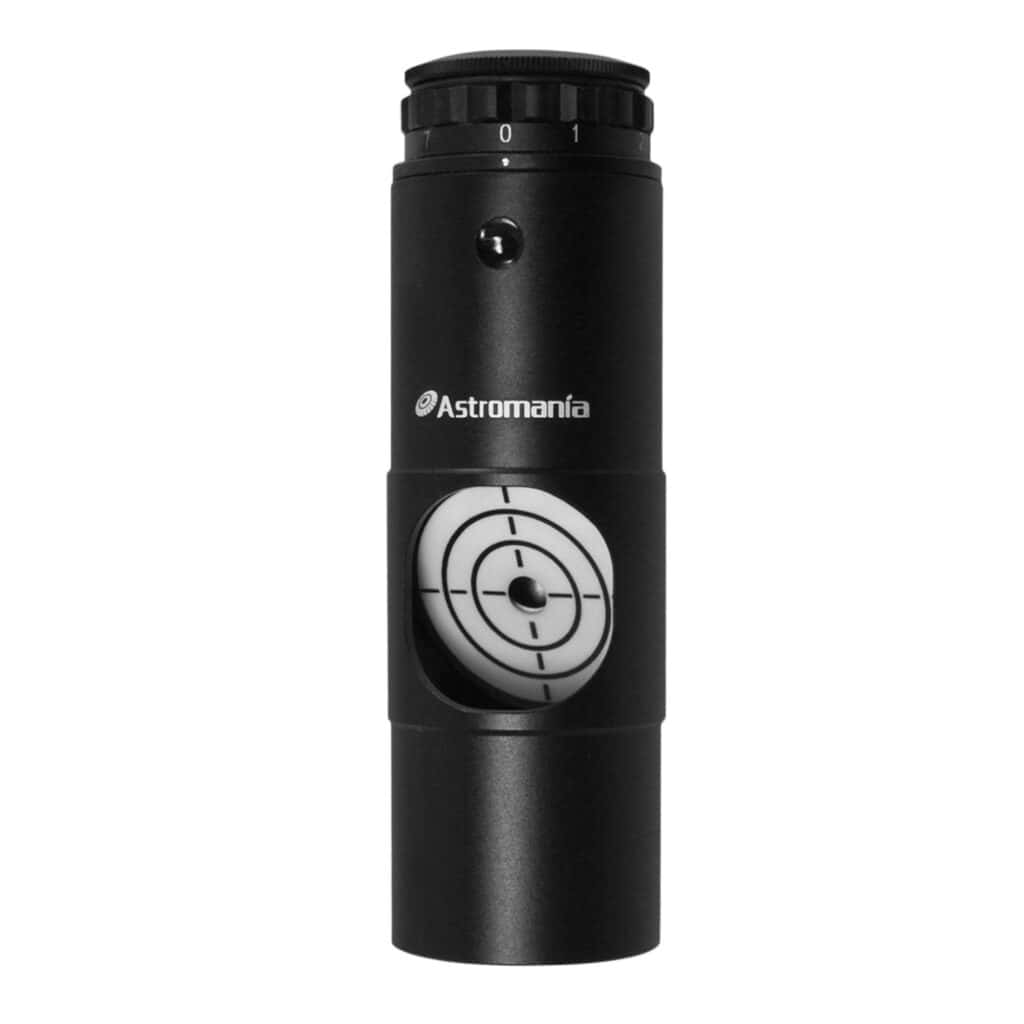
After using the Astromania Laser Collimator, I’m confident it’s a solid choice for anyone who needs quick and precise collimation for their Newtonian telescope.
Pros
Cons
From the get-go, I appreciated how the alignment process was streamlined with this collimator. Designed specifically for reflector telescopes, the compact device slides easily into the 1.25-inch focuser. Adjusting the mirrors of my Newtonian telescope turned into a solo task that was accomplished in minutes.
The construction feels substantial, thanks to the quality metal build. There’s no feeling of fragility when handling this collimator, suggesting to me it will have a long lifespan in my astronomy toolkit. The anodized aluminum gives it a professional look, which complements its practical functionality.
Brightness adjustability is a feature I find particularly useful during twilight hours when too much laser light can be a nuisance. With seven levels to choose from, landing on the optimal brightness meant less eye strain and more accurate adjustments. The visibility of the red laser beam was clear under various lighting conditions, an essential factor for precise collimation.
Now, every tool has its downsides, and I did grumble about the absence of a battery. While CR2032 batteries aren’t hard to find, it’s an extra step before first use. The manual, while comprehensive, might require a newcomer to give it a couple of reads to get into the swing of things. Lastly, slotting in the battery felt overly delicate, and I could see this being a minor irritation for some users.
Nevertheless, given its high quality and specialized design, the Astromania Next Gen Laser Collimator proved to be a reliable accessory. It’s a purchase I’d recommend to fellow astronomers for maintaining the performance of their reflector telescopes.
Astromania Next Gen Laser Collimator
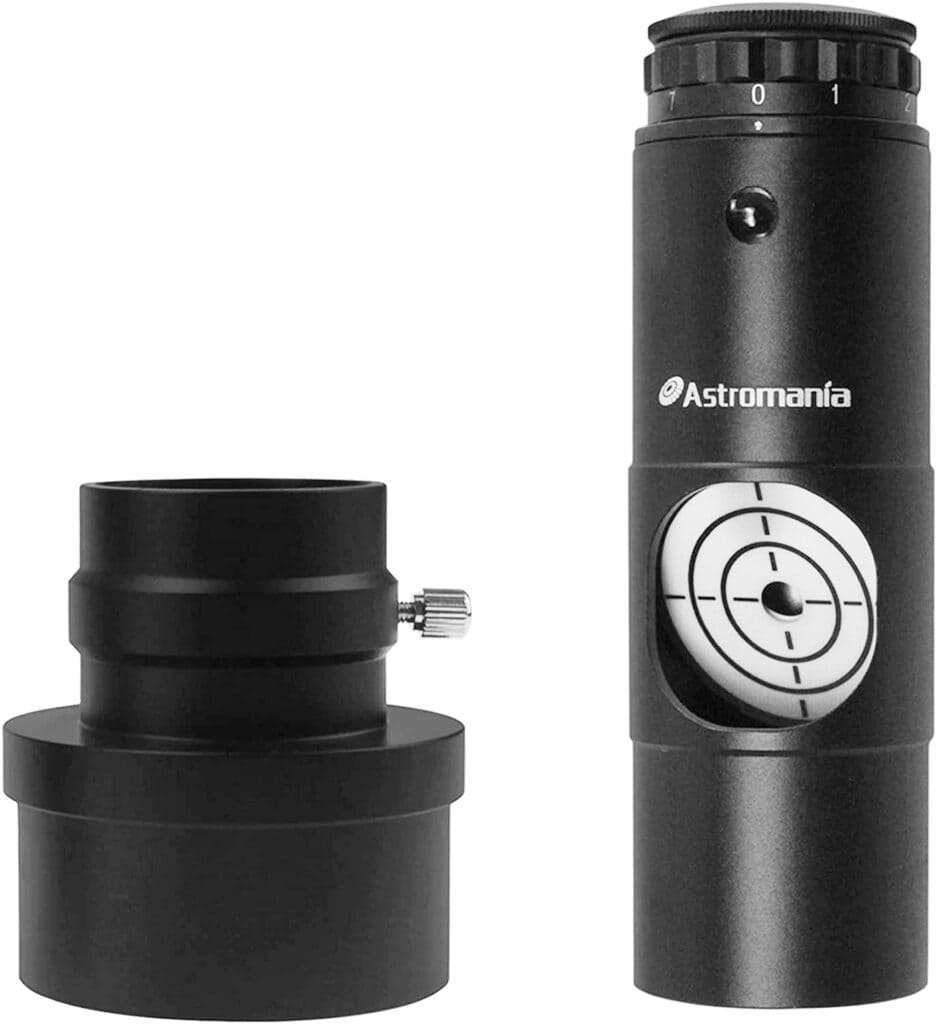
After fine-tuning my Newtonian telescope optics with the Astromania Next Gen Laser Collimator, the clarity and precision I’ve achieved make it a must-have for any astronomy enthusiast.
Pros
Cons
My stargazing sessions have reached new heights since I incorporated this laser collimator into my routine. Its precision greatly reduced the time I spent fumbling with my telescope’s alignment. The sturdy build gave me peace of mind, knowing that this tool can withstand the rigors of regular use. Plus, seeing the laser reflect back perfectly off the 45-degree plate assured me my optics were properly aligned.
I appreciated the fact that the collimator came pre-adjusted; this saved me a step and let me get straight to observing. Should there be a need for adjustments down the line, the built-in screws are there for fine-tuning. The inclusion of the adapter for 2-inch focusers meant I could recommend it to fellow astronomers without hesitation, regardless of their telescope model.
Although I was slightly annoyed at having to purchase a separate battery, this was a minor setback compared to the overall benefits. The device powered up without a hitch, and the 7 different brightness levels, while initially indistinct, allowed me to select the ideal intensity for any viewing conditions. Mastery over the collimator’s features quickly followed initial experimentation.
In summary, the Astromania Next Gen Laser Collimator is a top-performing aligner that’s equally suited for seasoned star gazers and those new to the cosmos. It’s a component I now count as indispensable in my astronomical toolkit.
Alstar Laser Collimator
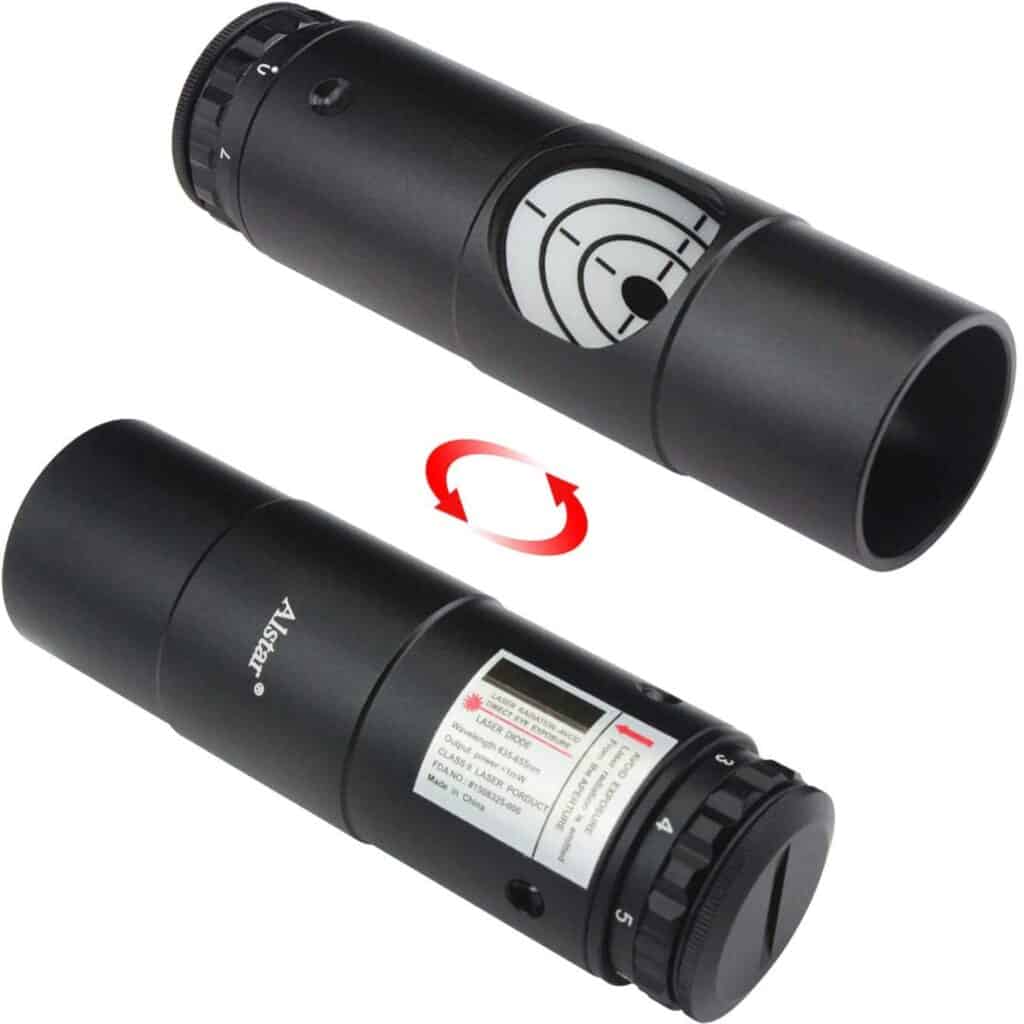
I just used the Alstar Laser Collimator on my Newtonian, and the difference in clarity after proper collimation is remarkable.
Pros
Cons
Having recently spent the evening under the stars, I found myself impressed by how quickly the Alstar Laser Collimator brought my telescope into sharp focus. There’s no overstating the ease of use, with precollimated optics allowing me to get straight to observing without fuss. The ability to work with all 1.25″ focusers piqued my interest as I could use it across multiple telescopes in my collection, a clear win for any amateur astronomer with a growing setup.
The build quality deserves a mention too; the aluminum construction feels solid in hand, ensuring that this tool can withstand the rigors of regular use. The adjustment instructions provided were concise, aiding me in achieving optimal performance. Moreover, with seven levels of brightness, the red laser beam remained clearly visible against the night sky, ensuring precise alignment.
Reflecting on my experience, it’s critical to acknowledge the importance of reading the instructions carefully. Novices may find it challenging at first, but with a little patience, the process becomes straightforward. Not having the CR2032 battery included was a bit of an inconvenience, but they’re readily available at most stores. Ensure that you handle the tool with care to maintain its calibration for reliable performance each time.
SOLOMARK NextGen Laser Collimator
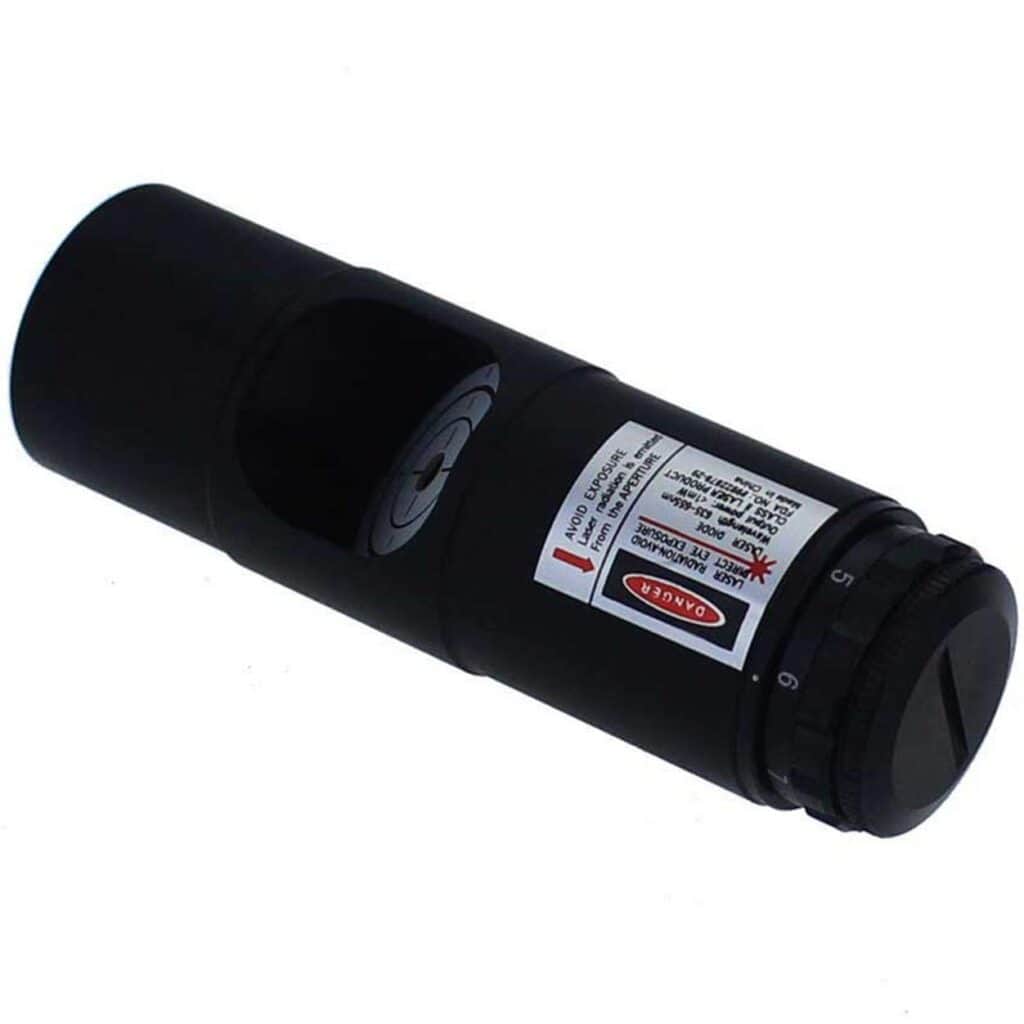
After some hands-on time with this tool, I’m assured any astronomy enthusiast would appreciate how it enhances their stargazing precision and experience.
Pros
Cons
Aligning my telescope’s mirrors used to be a trial-and-error process, but since I’ve started using the SOLOMARK NextGen Laser Collimator, the task has become a breeze. Its robust metal build gave me the confidence to handle the device without kid gloves. I didn’t worry about a drop damaging it; even then, readjustments were straightforward and painless.
Bright and distinct, the laser beam cut through the ambient light, making collimation simple, even during dusk. Operating it single-handedly meant I could spend less time on setup and more on actual observation. My telescope’s imagery sharpened up after proper alignment, something I could impressively manage with just a glance through the side window.
However, not everything was perfect straight out of the box. I needed to tweak the collimator a bit on arrival to perfect its precision. This hiccough aside, I acknowledge not needing a toolkit for battery replacement as a thoughtful design detail. Remember, a CR2032 battery will need to be sourced before use – a slight inconvenience, but a one-time bother.
The device’s fit within the eyepiece holder also left a bit to be desired. I found that securing it properly was key to an accurate calibration, which sometimes meant a bit of extra fiddling. That said, once it was snug, the seven-level brightness control provided excellent visibility under varying conditions.
In summary, the SOLOMARK NextGen Laser Collimator is reliable, well-built, and a valuable addition to any reflector telescope setup. Despite minor caveats, the advantages it offers in ease of use and consistent performance can significantly enhance any stargazing session.
Buying Guide
Key Features to Consider
When choosing the best laser collimator, I look for accuracy, ease of use, and durability. These key features ensure that my telescope is perfectly aligned for the best viewing experience.
- Accuracy: The collimator must provide precise alignment of the telescope optics to ensure clarity and sharpness.
- Ease of Use: It should be straightforward to operate, even for beginners, with clear instructions.
- Durability: A robust construction prevents damage from regular use and transport.
Compatibility
It’s essential to ensure the collimator is compatible with my telescope’s size and type. I typically check the size of the focuser against the collimator’s fitting.
- Focuser Size: Match my telescope’s focuser diameter with the collimator’s barrel size (common sizes include 1.25″ and 2″).
- Type of Telescope: Consider whether my telescope is a reflector or refractor, as some collimators are designed specifically for one type or the other.
Adjustment Features
Fine-tuning capabilities are crucial for accurate collimation. I prefer collimators with adjustable brightness and laser precision.
| Feature | Why It Matters |
|---|---|
| Adjustable Brightness | For clear visibility in various lighting conditions. |
| Laser Precision | To ensure the laser dot is centered for optimal alignment. |
Build Quality
I examine the materials used, such as metal over plastic, to guarantee longevity and stability during the collimation process.
- Material Quality: A metal build often implies a sturdier and more reliable tool.
- Design: A sleek, compact design is beneficial for easy handling and storage.
By considering these factors, I can make an informed decision to find a laser collimator that meets my requirements, offering reliable and efficient performance to enhance my astronomical observations.
Frequently Asked Questions
In this section, I provide answers to some common queries about laser collimators to aid in fine-tuning your telescope’s alignment for optimal performance.
What are the advantages of using a laser collimator for telescope alignment?
A laser collimator offers precise and quick alignment of your telescope’s optics. It simplifies the process by providing a visible beam that can be used to align mirrors and lenses accurately.
How does a Hotech Laser Collimator compare to other brands in terms of accuracy and build quality?
My experience with a Hotech Laser Collimator reveals that it often surpasses other brands in accuracy due to its advanced alignment system and solid build quality that ensures durability and consistent performance.
Can a Howie Glatter Laser Collimator be used effectively with all types of telescopes?
A Howie Glatter Laser Collimator is versatile and can be used with various telescope designs, including reflectors, refractors, and compound telescopes, facilitating effective alignment across different models.
What should one consider when choosing a laser collimator for a Dobsonian telescope?
When selecting a laser collimator for a Dobsonian telescope, consider the size of the laser to ensure compatibility with the focuser, the ease of adjustment it offers, and its ability to maintain collimation over time.
How does the SVBONY Laser Collimator performance measure up for amateur astronomers?
For amateur astronomers, the SVBONY Laser Collimator is a cost-effective choice providing satisfactory alignment, though it may lack some features of higher-end models that offer greater precision.
What are the key differences between the Next Generation and traditional laser collimators?
Next Generation laser collimators typically feature enhanced technology for better accuracy, user-friendly interfaces, and improved build quality, distinguishing them from traditional laser collimators which are simpler in design and function.

